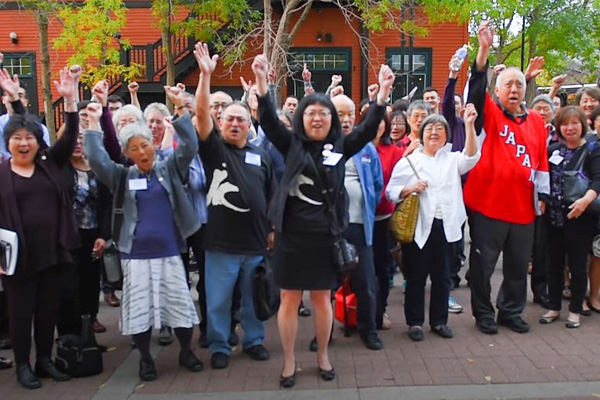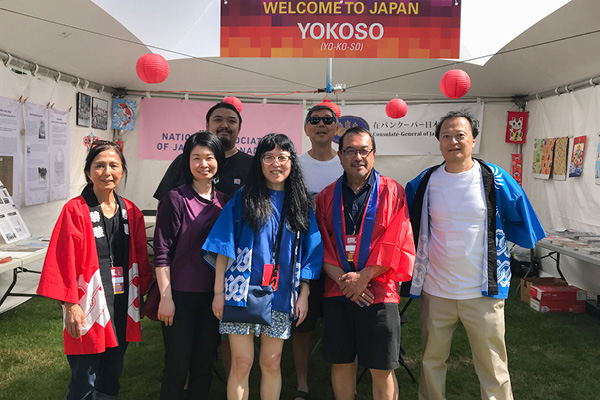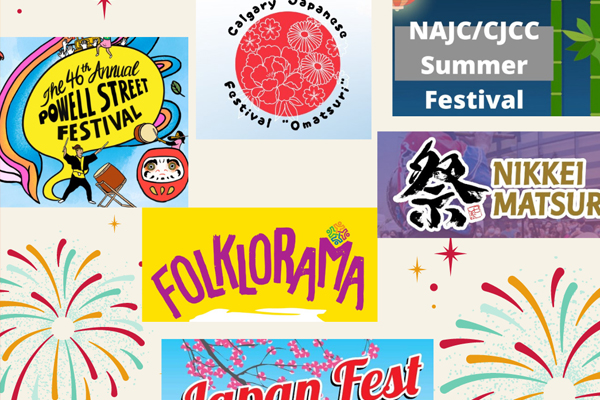by Ken Noma
On Monday, July 8th at the NAJC Winnipeg office, an agreement was reached between the Canadian Museum of Civilization, the Nyce family and the NAJC to return the gillnet boat, Nishga Girl, to the new Canadian Museum of History.
In attendance were Chief Harry and Deanna Nyce; Sigimnak’ Angaye’e Shirley Morven (Chair, Council of Elders, Nisga’a Lisims Government); Mark O’Neill (President and CEO of CMC); Chantal Schryer (VP, Public Relations, CMC); Terumi Kuwada (NAJC past president) and myself. Sim’oogit Sagaw’een Chief Nyce, in the full regalia of a Nisga’a hereditary chief of the Laxsgiik – Eagle Clan, said words of welcome and led the group in a prayer to the ‘Great Spirit’ for guidance.
In the opening remarks, Chief Nyce spoke of the important role played by Nishga Girl in providing a good quality of life to his family and how the boat gave his family the means to pursue educational opportunities. He spoke of the long and respectful relationship between the Nyce and Tasaka families that began with his grandfather, Eli Gosnell and “Judo” Jack Tasaka. It was his grandfather who advised the Nisga’a not to purchase any Japanese Canadian fishing boats seized by the Canadian authorities. Both men fished the mouth of the Skeena River and Eli shared his knowledge of boat building with Judo Tasaka. It was Eli who helped the Tasaka family regain their financial independence after the internment. The Chief also revealed that there was a small, over-gown Japanese graveyard on Nisga’a land which dates back to the cannery days of the Hudson Bay Company in the late 1800’s. Professor Richard Garvin, UBC Okanagan Campus, has taken a picture of the monument found in the Japanese plot of Gingolx Cemetery and has promised to provide me with more information after he consults his field notes.
On behalf of the Museum, Mark O’Neill apologized for the removal of the Nishga Girl. He stated that the CMC failed to consult both communities and that the removal of the boat should not have happened. As a result of this mistake it was his personal wish to be here and to reach a respectful outcome that will satisfy both the Nyce family and the NAJC. He noted that the current Museum’s history begins with the Vikings and not First Nations and the exhibits end in the 1970s with no mention of the Japanese Canadian Redress Settlement or the current developments in the history of First Nations people. The NAJC and the Nyce family offered their services to help create a more accurate history of our communities in the new Museum.
The lessons of the Nishga Girl and the November 10, 2010 ‘Too Asian’ article in Macleans magazine and other similar events from the past, teaches us to be relentless in our vigilance and united in our demand for inclusion. Until the history of immigrants to Canada and Canada’s First Peoples is acknowledged and honoured by those who control the educational institutions, publishing houses and museums, Canada’s history will only be that of the status quo. Chief Nyce noted that without the support of the NAJC, this issue would not have been resolved. His comment is all the more reason for Canadians to take up the cause of Canada’s First People – similar to the ‘Canadians for Redress’ movement which broadened the Redress campaign from an ethnic issue to an issue dealing with fundamental rights of all Canadians.
In my March 2011 President’s Report, I reported on the Canadian War Museum’s “Forced Relocation” exhibit dealing with Japanese Canadian internment. The exhibit had been placed in a small room opposite a map of the Pacific which showed the extent of Japanese military expansion during the Second World War. In the mind of the viewer, these two events were tied together and perhaps leading one to conclude that the Japanese Canadian internment may have been justified given Japan’s militarism – guilt by association:
Projected on the floor was a red sun with emanating rays – I stumbled as I narrowly avoided stepping on it.
It was the Japanese flag, or more correctly, the active ensign of the Japan Maritime Self-Defense Force. The image was dead-centre and if one was busy looking at the wall displays, you would have stepped on it, as many people did during the time that I was there . . .
The exhibit failed to mention that 75% of the uprooted and expelled Japanese Canadians were Canadian born or naturalized citizens thus giving the impression that all were non-citizens of Canada. The text accompanying the photographs of the internment camps implied that life was normal in these camps and ignored the poor quality of the hastily constructed cabins that housed over 8 people each, with no insulation with inadequate heat from a small stove. A total of six major flaws were identified by the NAJC Ad Hoc Committee formed to negotiate changes to the Japanese Canadian exhibit. The Committee was composed of Grace Thomson (Chair & Past President), Ann Gomer Sunahara and Dr. Roy Miki.
It bears noting that the official tasked with negotiating changes to the War Museum display with the NAJC was the same Mark O’Neill that we met on July 8th. Is it me or do I detect a troubling pattern here?
When I assumed the Presidency of the NAJC, I was asked by a sansei leader from a prominent Toronto Nikkei organization about the relevance of the NAJC after the Redress settlement – I hope he has his answer and that he also realizes that assimilation does not equate to acceptance by the dominant culture.
I thank Nishga Girl for helping us to honour the memory of Eli Gosnell and “Judo” Jack Tasaka. She has reminded us to honour our bond with the Nisga’a First Nations and with the Nyce family.
The NAJC will remain vigilant for next time.




